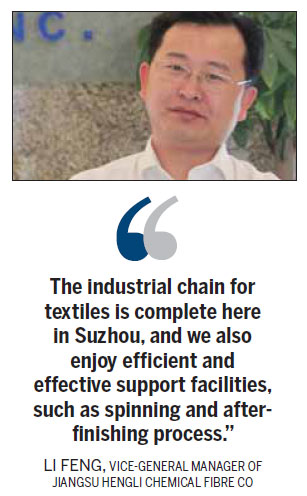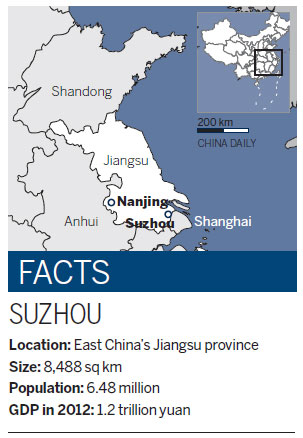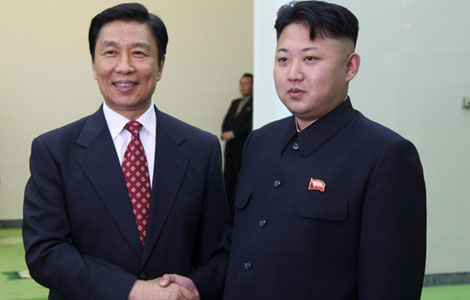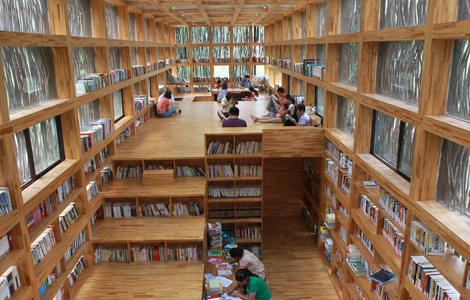
|
Chinese textile manufacturers are aiming to reposition themselves higher up the industry value chain. Photos by Provided to China Daily |
|
A franchise store of Aoyang Group. Provided to China Daily |

The main business fabric of Suzhou is being altered to fit the rest of the world
The once-prosperous textile makers of Suzhou may be at a tipping point. As is happening in other industries and cities in China, they are on the cusp of a major shift from being an export-driven, inexpensive, mass-production industry to becoming a more innovative, competitive and better quality.
Suzhou, often referred to as the birthplace and capital of the Chinese textile industry, recorded $7.05 billion in textile exports in the first half of this year, a year-on-year increase of 6.5 percent, according to statistics released by local government.
The figures may look good, but are deceptive.
"Despite the large volume, textile makers are making little profit," says Chen Yuyue, professor at the colleges of textile and clothing engineering of Soochow University, and a 30-year veteran of the industry. "Many of them even make a loss, taking operation costs into consideration."
Chen recalls the "good old days" of the 1990s when Suzhou, and China as a whole, enjoyed the advantages of low raw material and labor costs.
"But now, these advantages are fading away," he says. "As the price of raw materials and labor costs have increased, the profit margins have diminished, which imposes great challenges for local textile producers."
The rising value of the yuan has also played a role, he adds, "exerting pressure on textile exporters".
Shen Guojun, chairman and CEO of China Yintai Investment Group, says the current problems in the textile industry are not limited to Suzhou.
"It reflects China as a whole, whose economy is largely driven by exports," Shen said during the 6th China Green Companies Annual Summit held by China Entrepreneur Club in Kunming in April.
Chinese manufacturers should strive to move up the value chain and establish more global brands, "instead of just doing OEM (original equipment manufacturing) and winning market share and foreign exchange through cheap labor products, as it did many years ago", Shen stated.
But that's a lot easier said than done, according to professor Chen.
"Comparatively speaking, Chinese textile companies are rather weaker than those of developed nations in terms of brand building and technology innovation," he says. "These measures usually require heavy investment and are also high-risk.
"Everyone knows that it is essential to reposition themselves and then build up, but for most local textile manufacturers, the complicated market structure and huge marketing expenses are far beyond their capacity. That's why most local producers just engage in taking orders and then manufacturing the fabrics, or just doing OEM for foreign luxury brands."
But if there's going to be change, then Suzhou is a good place to be. The city still enjoys many favorable conditions and there is confidence all round that its textile industry can be revitalized.
Shengze town in Suzhou's Wujiang city, is showing the way to successful upgrading and transformation by developing a comprehensive system to help textile companies build their own brands and expand overseas.
With more than 2,300 textile companies based there, the industry accounted for 90 percent of Shengze's GDP last year. Half of the area's 8.5 billion meters of fabrics produced annually are sold to more than 100 countries.
Li Feng, vice-general manager and secretary of the board of Jiangsu Hengli Chemical Fibre Co, one of the largest textile producers, says the area is doing well due to the cluster effect and an improvement in the research and development capacities of its companies.
"The industrial chain for textiles is complete here in Suzhou, and we also enjoy efficient and effective support facilities, such as spinning and after-finishing process," says Li. "More importantly, as the traditional hub of textile manufacturing, Suzhou is a strong base for R&D.
"For every Chinese company, increasing labor and raw material costs are inescapable. The solution is to reduce the costs through developing more value-added products by investing more in R&D."
Every year, Hengli, which produces more than 7,000 types of fabric, invests about 3.5 percent in R&D at four centers across the world in Japan, Germany, Italy and France. The group has also appointed about 30 foreign designers.
"The developed nations are quite sensitive to changes in fashion trends, and the overseas R&D centers provide a good window for us to contact global markets," says Li.
Since its establishment in 1994, Hengli's sales revenue has increased from 3 million yuan ($488,000; 371,000 euros) to about 85 billion yuan last year, and its work force to more than 50,000.
Last year, the group gained sales revenue of more than 50 billion yuan from textiles, of which about 5 billion were exports, a 30 percent increase on 2011. Revenue is expected to hit 130 billion this year, says Li.
Another big local textile producer, Jiangsu Shenghong Group, is seeking cooperation with foreign partners in an effort to grab a bigger share of the overseas market.
Its sales revenue last year was 36.5 billion yuan, compared to 26.8 billion yuan in 2011. More than 80 percent came come from the textile industry, with about 10 percent of products being sold to the Middle East, Europe and US.
This year the group is likely to increase sales revenue by 50 billion yuan, according to a senior official of the group, surnamed Gao.

He says Shenghong invests about 3 percent of its revenue in R&D every year.
"We have been developing more value-added products and looking for opportunities with foreign partners to cater to the fast-developing overseas market," Gao says. "Through cooperation with overseas partners, such as setting up factories overseas, we can lift limits on export quota."
About 100 kilometers from Shengze is Zhangjiagang, another textile production hub. Here, many local textile companies are focusing more on the high-end market by establishing their own brands and opening retail stores.
Shen Xueru, 59, president of Zhangjiagang Aoyang Group, says that over the next five to 10 years "we will gradually transform from a company which just conducts OEM and traditional textile fabrics to one famous for our own high-end textile products", principally clothing, beginning with menswear.
He says last year the group produced about 10,000 tons of wool, or 10 percent of the total production capacity of the nation. Wool sales account for about 20 percent of the group's total sales of 20 billion yuan, and more than 90 percent of wool products were for export.
But the profit margins of wool exports are declining sharply because of the yuan appreciation.
"That's why we want to set up our own clothing brands, to tap this more profitable sector," Shen says.
The group began to establish franchised stores to sell its own brand clothing in April last year and the results so far have been encouraging.
"Aoyang plans to increase the number of outlets to 80 by the end of this year," Shen says.
It is expected sales revenue for Aoyang will hit 24 billion yuan this year. Last year, the group made a profit of about 300 million yuan.
Shen, who is also the director of Zhangjiagang Textile Association, says the one thing China's textile industry lacks is unique design.
"We have invited some famous designers from Italy to help in the designing of the clothes," he says.
Shen believes the transformation of China's textile industry will be a long one, but the outlook is promising.
"Despite the challenges, I strongly believe that in 20 or 30 years, the Chinese textile brands will shine in the global textile industry," he says.
Contact the writers through huhaiyan@chinadailly.com.cn
(China Daily Africa Weekly 07/26/2013 page16)








